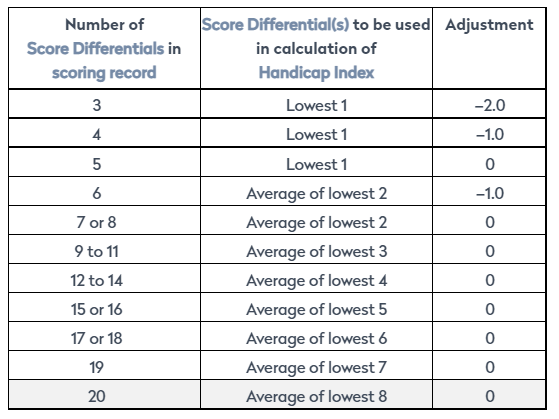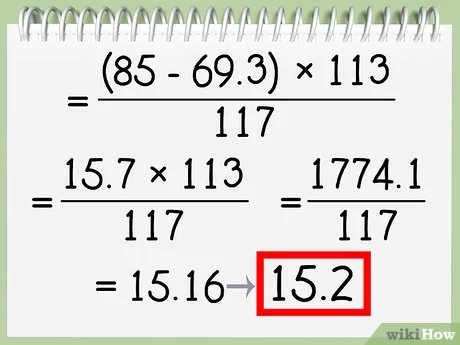Figuring out your golf handicap can seem tricky. But it’s not as hard as you think.
Golf handicaps help level the playing field. They allow players of different skill levels to compete fairly. Understanding your golf handicap can improve your game. It shows you where you stand and what to work on. This guide breaks down the steps to calculate your handicap.
You’ll find it easier than you expect. Plus, knowing your handicap can make playing golf more fun. Whether you’re new to golf or looking to get better, learning how to figure out your handicap is a great place to start. Let’s dive in and make this simple.
Introduction To Golf Handicap
Golf is a sport that many people enjoy. Each player has different skills. This makes it hard to compare scores. Golf handicap helps solve this problem. It levels the playing field. Everyone can compete fairly. Whether you are a beginner or a pro, a handicap is useful.
A golf handicap is a number. It shows a golfer’s skill level. Lower numbers mean better players. Higher numbers mean less experienced players. It allows players of different skill levels to compete. Both can enjoy the game more.
Purpose Of A Handicap
The main purpose of a golf handicap is fairness. It helps balance the competition. A skilled player can compete with a beginner. Both have an equal chance to win. This makes the game more enjoyable for everyone.
Handicaps also help track progress. As you improve, your handicap lowers. This shows your growth in the sport. It is a great motivator. You can see your hard work paying off.
Benefits For Beginners
Beginners benefit a lot from having a handicap. It makes the game less intimidating. They can compete with experienced players. Without feeling overwhelmed. This boosts confidence and enjoyment.
A handicap also helps beginners see their improvement. As they play more, their handicap changes. Lower numbers mean they are getting better. This encourages them to keep playing.
Golf is a social sport. Having a handicap helps beginners join more games. They can play with friends of all skill levels. This makes the sport more inclusive and fun.
Basic Terminology
Understanding the basic terminology of golf handicap is crucial. This knowledge helps you calculate your handicap accurately. Let’s explore some essential terms used in golf handicap.
Handicap Index
The Handicap Index is a measure of your playing ability. It reflects your potential skill level. A lower Handicap Index indicates a better golfer. This index is calculated based on your scores. It adjusts according to the difficulty of the courses you play.
Course Rating And Slope
Course Rating and Slope are key factors in determining your handicap. The Course Rating measures the difficulty of a golf course for a scratch golfer. A scratch golfer is someone who shoots par on any course.
The Slope Rating indicates the difficulty for an average golfer. It compares their performance to a scratch golfer. Higher Slope Ratings mean a more challenging course for the average golfer.
Understanding these ratings helps you calculate a fair handicap. It ensures that your handicap reflects your true playing ability.
Calculating Your Handicap
Understanding your golf handicap is essential. It levels the playing field. A handicap allows you to compete fairly with others. But how do you calculate it? Let’s break it down.
Recording Scores
First, you need to record your scores. Play a few rounds of golf. Keep track of your scores for each round. Most golfers use a scorecard. Make sure to record every score accurately.
| Round | Score |
|---|---|
| 1 | 85 |
| 2 | 90 |
| 3 | 88 |
Using The Handicap Formula
Once you have your scores, use the handicap formula. The formula is simple:
Handicap Index = (Score - Course Rating) x 113 / Slope Rating- Score: Your total score for the round.
- Course Rating: Difficulty of the course for a scratch golfer.
- Slope Rating: Measure of difficulty for a bogey golfer.
For example, if your score is 85, the course rating is 72.5, and the slope rating is 130, the calculation would be:
(85 - 72.5) x 113 / 130 = 10.88Repeat this process for several rounds. Then, average the results. This gives you your handicap index.

Credit: deercreekflorida.com
Using Handicap In Play
Using a golf handicap can make your game more competitive and enjoyable. It levels the playing field, allowing golfers of different skill levels to compete fairly. Here’s how you can use your handicap effectively during play.
Adjusting Scores
Adjusting scores based on your handicap ensures fair competition. Calculate your net score by subtracting your handicap from your total score. For example, if your handicap is 10 and you score 85, your net score is 75.
Equitable Stroke Control (ESC) helps manage score adjustments. ESC limits the number of strokes you can take on a hole based on your handicap.
| Handicap | Max Strokes per Hole |
|---|---|
| 0-9 | Double Bogey |
| 10-19 | 7 |
| 20-29 | 8 |
| 30-39 | 9 |
| 40+ | 10 |
Applying Handicap In Tournaments
Handicaps are vital in tournaments to ensure fair play. They allow players of different skill levels to compete equally. When entering a tournament, submit your most recent handicap index.
Many tournaments use stroke play format. In stroke play, your total strokes are counted, and your handicap is applied to get the net score.
- Submit your handicap before the tournament.
- Play the course and count your strokes.
- Subtract your handicap from your total strokes.
Some tournaments use match play format. In match play, handicaps are used on each hole to determine the winner. The player with the lower net score wins the hole.
- Determine strokes given based on handicaps.
- Play each hole and compare net scores.
- Count holes won to determine the match winner.
Using a handicap makes golf more enjoyable and competitive. It allows everyone to have a fair chance at winning.
Tools And Resources
Understanding your golf handicap can seem challenging. Thankfully, there are tools and resources to make it easier. These resources help you track scores, calculate handicaps, and improve your game.
Handicap Calculators
Handicap calculators are simple to use. They require a few details like course rating and slope. Enter your scores, and the calculator does the rest. Many websites offer free handicap calculators. These tools help you understand your current skill level. Knowing your handicap helps in tracking your progress.
Golf Apps
Many golf apps include handicap tracking features. These apps are available for both Android and iOS devices. You can log your scores after each round. The app calculates your handicap for you. Some apps also offer additional features like GPS tracking and course maps. These extra tools can enhance your overall experience.

Credit: www.wikihow.com
Improving Your Handicap
Improving your golf handicap can be a rewarding experience. The process requires dedication, practice, and sometimes professional guidance. Here are some effective strategies to help you lower your golf handicap:
Practicing Regularly
Consistent practice is essential. Try to schedule practice sessions several times a week. Focus on different aspects of the game during each session.
- Driving range sessions: Improve your swing and driving distance.
- Putting practice: Work on accuracy and control on the greens.
- Short game drills: Enhance your skills in chipping and pitching.
Tracking your progress is also important. Use a journal or a golf app to record your scores and identify areas for improvement.
Taking Lessons
Professional lessons can make a big difference. A golf instructor can help you identify flaws in your technique and provide personalized tips.
- Find a reputable instructor: Look for certified professionals with good reviews.
- Set specific goals: Communicate what you want to achieve with your instructor.
- Follow their advice: Practice the drills and exercises they suggest.
Lessons are an investment in your game. They provide structure and expert guidance, helping you improve faster than practicing alone.
| Practice Type | Focus Area | Frequency |
|---|---|---|
| Driving Range | Swing and Distance | 2-3 times/week |
| Putting Practice | Accuracy and Control | 2-3 times/week |
| Short Game Drills | Chipping and Pitching | 1-2 times/week |
Common Mistakes
Understanding how to calculate your golf handicap can be challenging. Many golfers make common mistakes that can throw off their scores. Addressing these mistakes can help improve your game and ensure accurate results. Let’s discuss a few of these common errors.
Incorrect Scorekeeping
Incorrect scorekeeping is a frequent mistake. Golfers sometimes forget to record their scores accurately. They might miss a stroke or miscount their total score. Always double-check your score after each hole. Use a reliable scorecard or a golf app to keep track. This will help avoid simple errors.
Misunderstanding Rules
Misunderstanding the rules is another common issue. Golf rules can be complex. Many golfers do not know the exact rules for various situations. For example, knowing how to handle penalties or out-of-bounds shots is crucial. Study the basic rules of golf. This knowledge will help you record scores correctly.
Staying Updated
Keeping your golf handicap accurate requires regular updates. This ensures fair play and reflects your current skill level. Staying updated involves reviewing your scores and updating your handicap regularly.
Reviewing Scores
Review your scores after every game. This helps track your progress. Compare your current scores with past performances. Look for patterns and areas to improve. Consistent reviews provide a clear picture of your game.
Updating Handicap Regularly
Update your handicap regularly. This keeps it accurate. Use official tools or apps for calculations. Enter your latest scores promptly. Regular updates ensure your handicap reflects your true abilities. This practice promotes fairness and enjoyment in the game.

Credit: www.randa.org
Frequently Asked Questions
What Is A Golf Handicap?
A golf handicap is a numerical measure of a golfer’s potential ability. It allows players of different skill levels to compete fairly.
How Do I Calculate My Golf Handicap?
To calculate your golf handicap, use your scores from recent rounds. Apply the handicap formula considering course difficulty and rating.
Why Is A Golf Handicap Important?
A golf handicap allows fair competition between players of different skill levels. It ensures everyone has an equal chance to win.
How Often Should I Update My Handicap?
Update your golf handicap regularly, ideally after every round. This ensures your handicap reflects your current playing ability.
Conclusion
Figuring out your golf handicap doesn’t need to be difficult. Follow the steps outlined and practice regularly. Understanding your handicap helps you track improvement. It also makes the game more fun and competitive. Share your progress with friends. Celebrate small achievements.
Keep playing and enjoy the game. Golf is about patience and persistence. Stay dedicated. Happy golfing!



